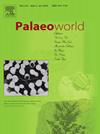墨西哥琥珀中已灭绝的树脂生产者新成员:Hymenaeaphyllum mirandae n. gen. n. sp.
IF 1.7
3区 地球科学
Q2 PALEONTOLOGY
引用次数: 0
摘要
墨西哥南部恰帕斯州最重要的琥珀矿床之一,出露有生物嵌合体,年代约为 23-15 Ma(中新世早中期)。被子植物(开花植物)是记录最频繁的类群,约有 16 个科主要以化石花和偶尔的叶为基础,其中包括豆科植物的成员。本研究报告了保存在墨西哥琥珀中的新的双小叶复叶,由一对小叶组成,小叶边缘附着在短叶柄上。每片小叶呈卵形至长圆形,边缘完整,先端渐尖,有羽状主脉。它们的特征与现存的 Cercidoideae、Caesalpinioideae 和 Detarioideae 亚科成员的双叶复叶相当。它们不对称的基部、肉质次脉以及丰富的半透明腺体,使我们能够确定一个新的已灭绝的生产树脂的 Hymenaea 支(Detarieae,Detarioideae)成员--Hymenaeaphyllum mirandae n. gen. n. sp. Hymenaea 支包括 Guibourtia、Hymenaea 和 Peltogyne,它们都具有相似的叶片结构和其他植物特征,包括生殖结构。Hymenaeaphyllum mirandae 与之前确认的已灭绝的树脂生产植物成员之间的联系尚不确定。在墨西哥琥珀中发现的Hymenaeaphyllum mirandae表明,在中新世时期,北方热带植物区系已经扩展到了北美洲的低纬度地区。本文章由计算机程序翻译,如有差异,请以英文原文为准。
A new extinct member of the resin producer group of the Mexican amber: Hymenaeaphyllum mirandae n. gen. n. sp. (Detarioideae-Leguminosae)
One of the most important amber deposits with bioinclusion outcrops in Chiapas, southern Mexico, dated ca. 23–15 Ma (early–middle Miocene). Angiosperms (flowering plants) are the most frequently recorded group, with ca. 16 families based principally on fossil flowers and occasional leaves, including members of Leguminosae. This study reports new bifoliolate-compound leaves preserved in Mexican amber, represented by a pair of leaflets marginally attached to a short petiole. Each leaflet is ovate to oblong with an entire margin and has an acuminate apex with a pinnate primary vein. Their characteristics are comparable with bifoliate compound leaves of extant members of Cercidoideae, Caesalpinioideae, and Detarioideae subfamilies. Their asymmetrical base, brochidodromous secondary veins, and abundant translucid glands allow establishment of a new extinct resin-producing member of the Hymenaea clade (Detarieae, Detarioideae), Hymenaeaphyllum mirandae n. gen. n. sp. Hymenaea clade includes Guibourtia, Hymenaea, and Peltogyne, all with similar foliar architecture and other plant characteristics, including reproductive structures. The connection of Hymenaeaphyllum mirandae with extinct members of resin-producing plants recognized previously is uncertain. The discovery of Hymenaeaphyllum mirandae in the Mexican amber suggests that the Boreotropical Flora extended to low latitudes of North America during the Miocene.
求助全文
通过发布文献求助,成功后即可免费获取论文全文。
去求助
来源期刊

Palaeoworld
PALEONTOLOGY-
CiteScore
4.00
自引率
5.90%
发文量
95
期刊介绍:
Palaeoworld is a peer-reviewed quarterly journal dedicated to the study of past life and its environment. We encourage submission of original manuscripts on all aspects of palaeontology and stratigraphy, comparisons of regional and global data in time and space, and results generated by interdisciplinary investigations in related fields. Some issues will be devoted entirely to a special theme whereas others will be composed of contributed articles. Palaeoworld is dedicated to serving a broad spectrum of geoscientists and palaeobiologists as well as serving as a resource for students in fields as diverse as palaeobiology, evolutionary biology, taxonomy and phylogeny, geobiology, historical geology, and palaeoenvironment.
Palaeoworld publishes original articles in the following areas:
•Phylogeny and taxonomic studies of all fossil groups
•Biostratigraphy, chemostratigraphy, chronostratigraphy
•Palaeoecology, palaeoenvironment and global changes throughout Earth history
•Tempo and mode of biological evolution
•Biological events in Earth history (e.g., extinctions, radiations)
•Ecosystem evolution
•Geobiology and molecular palaeobiology
•Palaeontological and stratigraphic methods
•Interdisciplinary studies focusing on fossils and strata
 求助内容:
求助内容: 应助结果提醒方式:
应助结果提醒方式:


